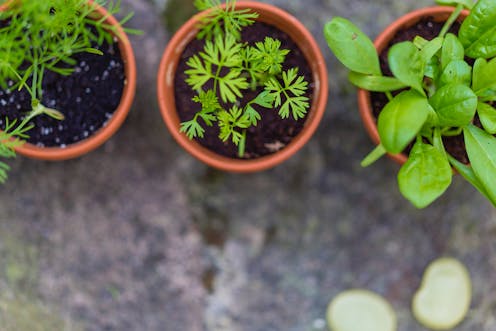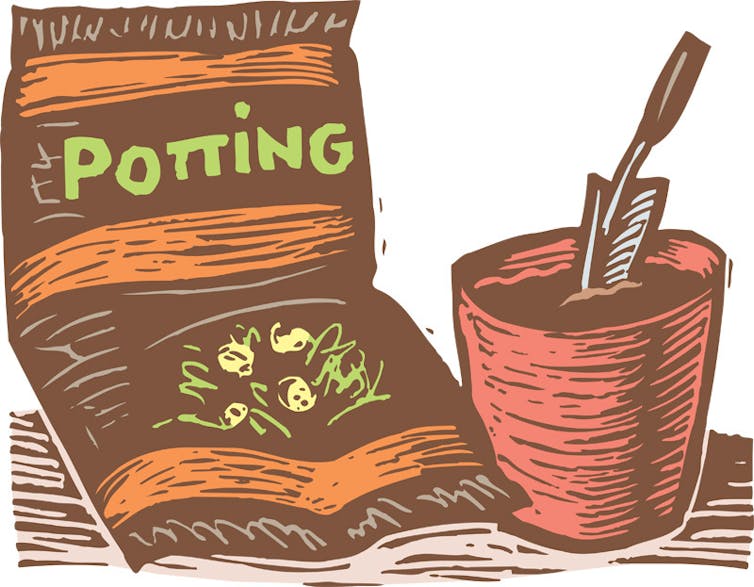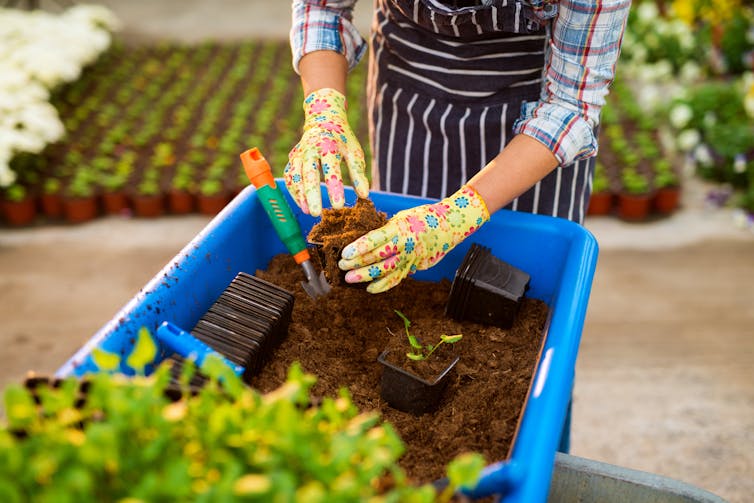Don't worry, the chance of dying from potting mix is very slim
- Written by Peter Collignon, Professor, infectious diseases and microbiology, Australian National University
 Potting mix is known to carry harmful bacteria and fungi.Photo by Markus Spiske on Unsplash
Potting mix is known to carry harmful bacteria and fungi.Photo by Markus Spiske on UnsplashGardening is generally a healthy and pleasurable hobby or occupation. However, any activity carries some risk – and gardening is no exception.
Potting mix is known to carry harmful bacteria and fungi. And there have been reports of deaths from diseases, such as the Legionnaires’ disease (a lung infection), that have been attributed to bacteria in potting mix.
Many bacteria and fungi that can cause infections in people live in soil and water. So it’s not surprising that potting mix can also have in it bacteria and fungi that may on occasion cause harm to people, and in rare cases even kill them. But it’s important to note that, overall, the risk is very low.
Read more: The science is in: gardening is good for you
Fertilising more than plants
Potting mix is usually a mixture of inorganic and organic material. It’s also often at a higher temperature compared to soil because of where and how it’s stored, so it retains heat for longer. Bacteria and fungi generally grow better and reach higher numbers when they are in moist and warm environments.
 Potting mix is usually warmer than soil, which makes it a better environment for bacteria and fungi to grow.from shutterstock.com
Potting mix is usually warmer than soil, which makes it a better environment for bacteria and fungi to grow.from shutterstock.comIf bacteria or fungi are already present in low numbers, they can quickly grow to very high numbers in optimal conditions. This includes many bacteria in soil that can cause problems in people – such as strains of nocardia (causes nocardiosis, an infection of the lungs or whole body), legionella (causes Legionnaires’ disease), and clostridium (causes tetanus).
Numerous fungi can also be present in soil and potting mix. In certain areas of the world, soil contains fungi that can invade if inhaled and cause disease. These include the lung infection histoplasmosis, which is caused by a fungus that lives mainly in parts of the United States, but also in some parts of Central and South America, Africa, Asia, and Australia.
Protecting ourselves
The risk to most people of becoming infected with any of these bacterial or fungal diseases is very low. Disease is more likely to be a risk when the micro-organisms are present in very high numbers.
Bacteria or fungi also need to be introduced into our bodies to cause disease. This usually happens through inhalation, where the organisms go into the lungs. It can also occur through the skin, such as with the chronic fungal infection sporotrichosis, also known as “rose gardener’s disease”. If, for any reason, micro-organisms are present in high numbers, then the exposure and risk will be higher.
 A fungal infection known as rose gardener’s disease can happen with the organism entering the skin directly through an injury.from shutterstock.com
A fungal infection known as rose gardener’s disease can happen with the organism entering the skin directly through an injury.from shutterstock.comThere are many things we can do to protect ourselves from introducing bacteria or fungi into our bodies. The most essential is basic hygiene.
If people smoke, eat or drink without first washing their hands, they are at an increased risk of legionella infection from potting mix. This implies direct inhalation isn’t the only way for the bacteria to enter the body, but that oral intake of micro-organisms via contaminated hands is also a risk.
Another added protection measure is wearing gloves. This doesn’t mean you should then not wash your hands before eating. A physical barrier in addition to washing hands obviously provides better protection.
Read more: (At least) five reasons you should wear gardening gloves
Masks can be worn in high-risk situations, such as when opening a bag of potting mix. Directing the bag away from the gardener when opened, and being in a well-ventilated area, will decrease any inhalation risk.
Signs of infection
People who have a lower immunity, such as those with diseases such as HIV or lymphoma, are more at risk of catching something from potting mix. So it’s even more important they use extra appropriate precautions, including wearing masks when in higher-risk situations.
 Simple safety provisions can protect us from harmful bacteria and fungi.Shutterstock
Simple safety provisions can protect us from harmful bacteria and fungi.ShutterstockThe symptoms or signs of infection acquired from soil or potting mix depend on where the infection is and what micro-organism is causing it. With potting mix, the main worry is legionella longbeachae. This generally causes a lung infection such as pneumonia.
Symptoms can initially be fever, aches and pains, which are fairly general of illness. But as the infection involves more of the respiratory tract, cough, shortness of breath and/or pain on breathing may develop.
Treatment
While potting-mix-linked legionella infections are uncommon, cases have occurred in countries including Australia, Japan and the US.
So, if people develop symptoms that are ongoing and have had recent exposure to potting mix within the incubation period (two to ten days after exposure), they need to seek medical help and make it clear to that person that they were worried about potting mix being involved.
It’s important to note the potting mix connection because antibiotics needed to kill legionella are different to standard penicillin-like antibiotics often used to treat pneumonia acquired in the community.
Read more: Are common garden chemicals a health risk?
Overall, though, we need to keep these risks in perspective. Millions of people garden and all will be exposed to soil and/or potting mix. Very few of these infections occur in Australia and elsewhere. Fairly simple provisions such as washing hands, wearing gloves and – where necessary – wearing a mask will ensure rates of infection remain low.
Peter Collignon does not work for, consult, own shares in or receive funding from any company or organisation that would benefit from this article, and has disclosed no relevant affiliations beyond their academic appointment.
Authors: Peter Collignon, Professor, infectious diseases and microbiology, Australian National University
Read more http://theconversation.com/dont-worry-the-chance-of-dying-from-potting-mix-is-very-slim-88569



















